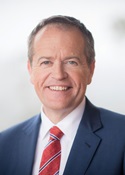Maribyrnong
Margin: Labor 11.4%
Region: Western Melbourne, Victoria
In a nutshell: Bill Shorten’s electoral home in Melbourne’s inner north-west extends from marginal Essendon and Moonee Ponds in the east to rock-solid Labor St Albans in the west.
Candidates in ballot paper order

|
TED HATZAKORTZIAN OLIVIA BALL BILL SHORTEN ANTHONY O’NEILL CATHERINE CUMMING FIONA McROSTIE |
Bill Shorten’s electorate of Maribyrnong has covered a shifting area around Essendon in Melbourne’s inner north-west since its creation in 1906. It consists of a moderately affluent and relatively Liberal-friendly eastern end around Essendon and Moonee Ponds, and a strongly Labor-voting western end including St Albans, Sunshine North and Braybrook, an area characterised by a large number of Vietnamese immigrants. In between lie Keilor East and Avondale Heights, a hub of Melbourne’s Italian community.
Labor has held Maribyrnong without interruption since 1969, prior to which it was held for the Liberals for 14 years by Philip Stokes. Stokes had emerged a beneficiary of the Labor split ahead of the 1955 election, at which preferences from the ALP (Anti-Communist) candidate enabled him to unseat Labor’s Arthur Drakeford by 114 votes, in what was only Labor’s second defeat since 1910. The seat finally returned to the Labor fold at the 1969 election when it was won by Moss Cass, who secured enough of a buffer through successive swings in 1972 and 1974 to survive Labor’s electoral winter of 1975 and 1977. In 1983 he bequeathed a double-digit margin to his successor Alan Griffiths, who enjoyed a 7.4% boost when the 1990 redistribution added St Albans. Griffiths was succeeded in 1996 by Bob Sercombe, who chose to bow out at the 2007 election rather than face preselection defeat at the hands of the national secretary of the Australian Workers Union, Bill Shorten.
Shorten came to parliament with a national reputation after positioning himself as the public face of the Beaconsfield mine disaster rescue effort in April-May 2006, and wielded great influence in the Victorian party factional system as a chieftain of the Right. However, Shorten was known to be hostile to Kevin Rudd, and rose no higher than parliamentary secretary for disabilities and children’s services during Rudd’s first term as Prime Minister. Shorten then emerged as one of the initiators of the June 2010 leadership coup, together with Victorian Right colleague David Feeney, and interstate factional allies Mark Arbib in New South Wales and Don Farrell in South Australia. After the 2010 election he was promoted to the outer ministry as Assistant Treasurer and Minister for Financial Services and Superannuation, and he then won promotion to an expanded cabinet by further taking on the employment and workplace relations portfolio in December 2011. Nonetheless, Shorten’s political stocks were generally thought to have been depleted by the political travails of Julia Gillard, whom he crucially abandoned in June 2013 to facilitate Kevin Rudd’s return. For this he was rewarded with a portfolio swap of financial services and superannuation for education.
After the 2013 election defeat, Shorten and Anthony Albanese of the Left emerged as the two candidates for the first leadership ballot held under the party’s new rules, in which the vote was divided evenly between the party membership and caucus. Albanese proved the clear favourite of the membership, in part reflecting the taint Shorten was perceived as carrying from his involvement in successive leadership coups against sitting prime ministers. However, Shorten’s 55-31 victory in the caucus vote was just sufficient to outweigh his 59.92% to 40.08% deficit in the ballot of approximately 30,000 party members, the combined result being 52.02% for Shorten and 47.98% for Albanese.
Analysis by William Bowe. Read William’s blog, The Poll Bludger.


